Japan January travel overview: season, food, nature, events
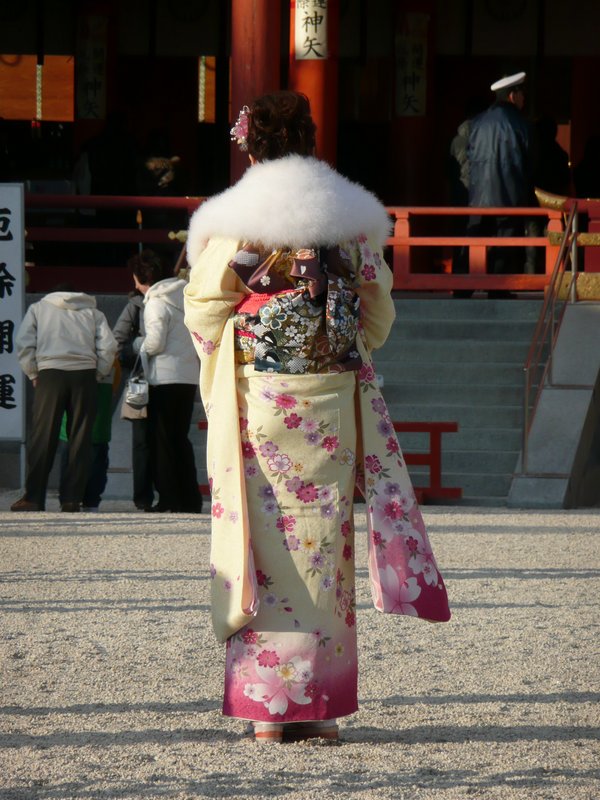
Travel in Japan in January offers foreign travelers a world of few crowds (and thus lower prices for rooms), winter sports, and serene snowy countryside scenes. The general exception would be the snow and skiing paradise of Hokkaido (especially holidays and weekends) and specifically Sapporo's annual Snow Festival which usually begins in late January.
January is mid-winter in Japan and generally the coldest month of the year. Japan is a very mountainous country, and also a long one, extending from northern Hokkaido at 45 degrees north latitude to Okinawa at 24 degrees north latitude (which is roughly 1,500 miles or 2,400 kilometers north to south). The Japanese Alps function as a "shield" against the super cold winds from China and Siberia. So, January in Kanazawa is much colder than January in Nagoya on the other side of the mountains. Although cities on the east like Tokyo can still experience cold temperatures in January, their winters are not nearly as harsh and windy, but you can count on a lot of sunshine to offset the gloom any cold snaps might bring.
In January, Tokyo, Osaka, Kyoto, and northern Kyushu experience average January highs of around 50° F (10° C), and lows of 36° F (2° C). If that's just too cold for you then consider ending your trip in the sub-tropical climes of Okinawa where January highs average 66° F (19° C), and lows of 57° F (14° C).
In the Japanese tea ceremony the month of January has been poetically captured with “goma” associations that capture the essence of the month. These key words and themes that have been classically repeated in Japan for more than 1,200 years. The January goma key words can help you “imagine” what to expect when you travel in Japan in that month. January goma themes: Hatsu mode: first visit of the year to a Shinto shrine; Oh Buku tea made with new year well water for good luck and good fortune; First night of the year and better dreams: the Japanese have a tradition of placing an image of the 7 gods of good fortune under their pillow the first night of the year; if dream of Mt. Fuji, it is an auspicious dream; if you dream of a hawk, is symbolizes bravery; and if you dream of eggplant, fertility; Nana kusa or The seven spring herbs: January 7th is the day traditional Japanese households eat rice porridge with seri (Japanese parsley), nazuna (shepherd’s purse), gogyo (Jersey cudweed), hakobe (common chickweed), hotoke no za (henbit), suzuna (turnip), and suzushiro (daikon); Hotei, one of the Seven Gods of Good Fortune, is strongly associated with January (and the New Year): Hotei is the god of fortune, guardian of children.
- Japan January travel food highlights
- Japan January travel tree and flower highlights
- Japan January travel festival | event highlights
- Winter onsen hot spring pleasures
- Trad Japan winter things: ceramic hot pots, hanten coats, hot water bottles
- Interview with Yoshinobu Hamano, 3rd generation tofu maker
Content by Ian Martin Ropke, owner of Your Japan Private Tours (est. 1990). I have been planning, designing, and making custom Japan private tours on all five Japanese islands since the early 1990s. I work closely with Japan private tour clients and have worked for all kinds of families, companies, and individuals since 1990. Clients find me mostly via organic search, and I advertise my custom Japan private tours & travel services on www.japan-guide.com, which has the best all-Japan English content & maps in Japan! If you are going to Japan and you understand the advantages of private travel, consider my services for your next trip. And thank you for reading my content. I, Ian Martin Ropke (unique on Google Search), am also a serious nonfiction and fiction writer, a startup founder (NexussPlus.com), and a spiritual wood sculptor. Learn more!
Japan January travel food highlights
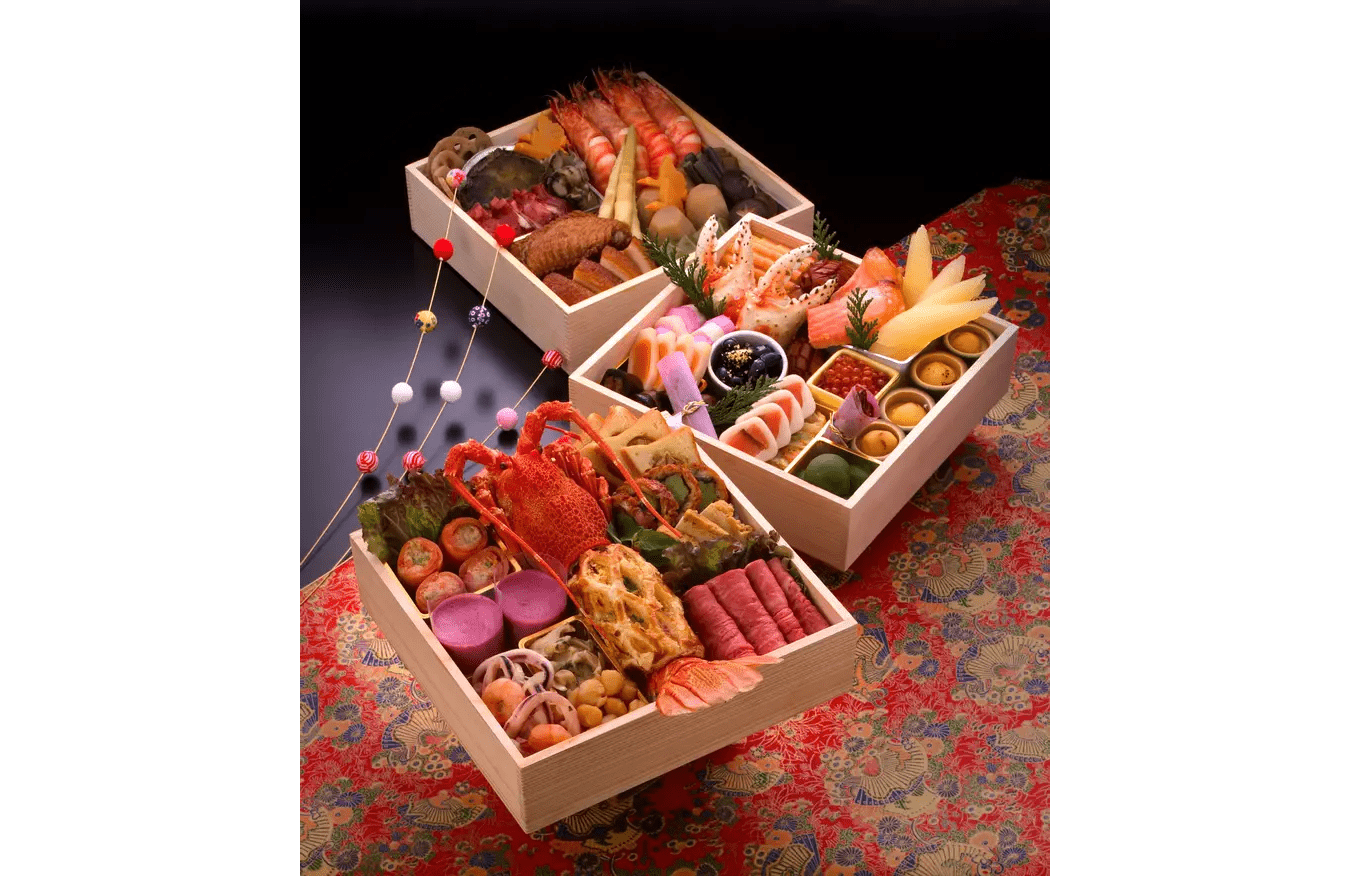
Since January is the low season month of Japanese winter and December is the high season month for travelers in general, I have placed all the winter foods in the December blog entry. The following foods are directly related to January only or almost entirely . . .
Obuku-cha or Daifuku-cha Tea: Translated as “big happy tea”, this New Year custom is particular to Kyoto. On the morning of New Year’s day, before drinking otoso first sake eating homemade osechi ryori delicacies (see below), Kyotoites drink hojicha roasted tea full of thin strips of kombu sea kelp, and small umeboshi pickled plums. Drinking daifuku-cha is said to keep you healthy and safe all year. Ask your inn keeper if they can let you sample a cup of this good luck drink. Ippodo and Fukujuen, two of Kyoto’s biggest traditional tea emporiums sell daifuku-cha.
Osechi Ryori: The main dishes of the traditional osechi New Year’s tray, prepared with much hard work by the women of the house, are symbolic of many good things. Unfortunately, most foreign January tourists will not actual be able to experience this high level cuisine moment that only lasts for three days (Jan 1-3). But if you are staying in a traditional ryokan inn, you will likely have a chance to sample some osechi ryori dishes. They are all symbolic! Herring roe symbolize fertility. Shrimp, with their bent back, the chance to live a long life, until our own backs bend. The many-holed lotus root symbolizes premonition, or the ability to see through to the 'other side'. Black beans are for hard work. And kelp stands for happiness and delight. Pink and white (auspicious colors in Japan) kamaboko are also part of the osechi tray. Some, when sliced, reveal a picture of Mt. Fuji, sunrise, cranes or bamboo leaves, all symbols of happiness. Vegetables are cut to resemble plums (happiness), chrysanthemums (longevity) or pine cones (prosperity). These three plants are also arranged on either side of the house gate. Though many still take the time to prepare their own osechi ryori at the year's end, even the rarest New Year foods can now be purchased at department stores and specialty shops.
- Japan January travel food highlights
- Japan January travel tree and flower highlights
- Japan January travel festival | event highlights
- Winter onsen hot spring pleasures
- Trad Japan winter things: ceramic hot pots, hanten coats, hot water bottles
- Interview with Yoshinobu Hamano, 3rd generation tofu maker
Japan January travel tree and flower highlights
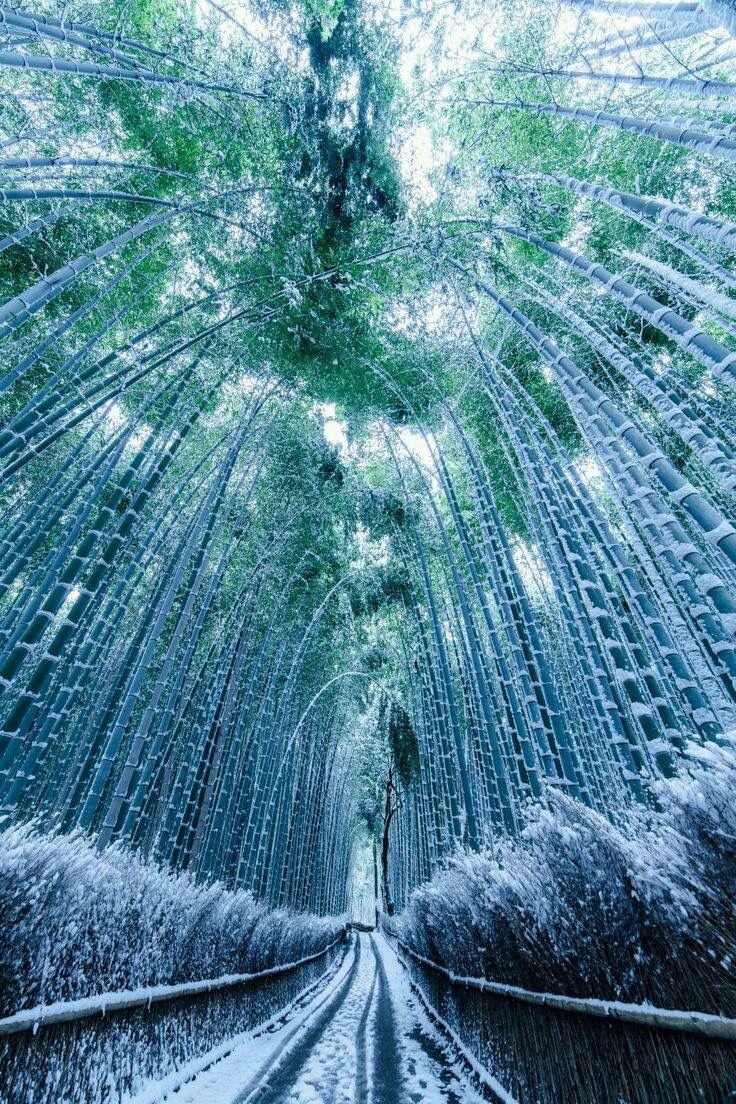
Though there are almost no flowers in January you can rely on seeing these four natural or garden related things this month: Suisen narcissus daffodils (all of Jan); bright red and white camellia blossoms (until early March, depending); amazing winter moments and scenes in bamboo groves (think snowy Japanese wonderlands!); and Japan’s amazing garden stones and superstitions (seriously serious!). The first two (Suisen daffodils and camellias) are detailed on the December blog entry (which is a high season month).
Bamboo groves: Deep winter wonders: Japan’s bamboo groves, especially in Kyoto’s Arashiyama and in Kamakura west of Tokyo, are popular and unique year round. There is a sense of aloneness that comes from standing in a bamboo forest and in winter this is especially poignant. And even better if snow is on the ground to highlight the contrast with the rich greens of the bamboo trunks. So, on snowy days do try to experience a bamboo grove: the bigger the better!
Japanese garden stone secrets and superstitions: Japanese garden stones, believe it or not, are the most important feature of any Japanese garden. If the earth is the “flesh” of the garden then the stones are it “bones.” In Japan garden stones are defined with three categories: "named" stones; unimportant "unnamed" stones; and stones that already existed on the site. Japan’s most famous named stone is called Fujito, after the beach in Okayama Prefecture where it was found. Its “owners” included Oda Nobunaga and Toyotomi Hideyoshi, two of the most daimyo or samurai warlords in Japanese history. Fujito was moved from garden to garden (wrapped in silk) to the accompaniment of live Shinto (gagaku) music. For the last 400 years, it has lived in a special garden in the Daigo-ji Temple complex in southeast Kyoto. Moving garden stones is something for expert Shinto priests as the Japanese superstitions concerning rocks are scary!
For the inexperienced, do-it-yourself Japanese landscape gardening can be a “Harry Potter” horror! There are many taboos or things to avoid when handling garden stones from small to huge. For example, bad fortune can come from setting upright a rock that was originally found lying horizontally on the ground or vice versa. Placing a stone in an upside-down position can release the evil spirits in the stone resulting in all manner of troubles for the garden owner.
Japanese garden stones are also “color coded” according to the five Chinese elements. Red for fire. Black for water. Blue/green for wood. White for metal. And yellow for earth. Here too mistakes can be made. For example, the “ignorant amateur gardener” might plant a tree with red blossoms, next to a red stone set in the south of a garden of a person born in a year associated with fire. This is called the “combination of four fires” and traditionally this was said to lead to the owner’s house burning to the ground!
- Japan January travel food highlights
- Japan January travel tree and flower highlights
- Japan January travel festival | event highlights
- Winter onsen hot spring pleasures
- Trad Japan winter things: ceramic hot pots, hanten coats, hot water bottles
- Interview with Yoshinobu Hamano, 3rd generation tofu maker
Japan January travel festival | event highlights
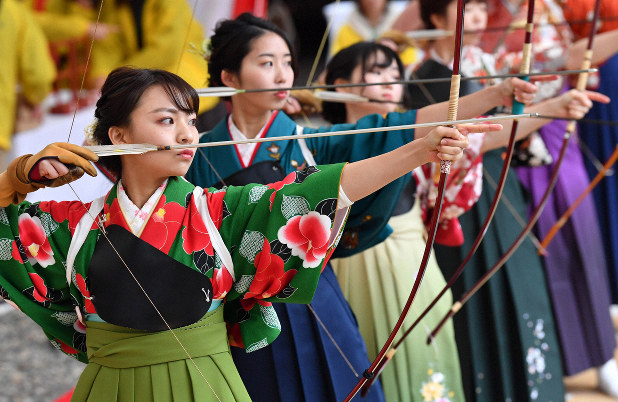
Japanese New Years (Jan 1-3): Japanese New Year is associated with a number of rituals, pastimes and foods in Japan. It's considered a family holiday. As a result, New Year's Eve isn't as much of a party night as it is in other countries. The rituals of Japanese New Years, such as waking up early to view the year's first sunrise, are thought to give you an auspicious start to the year.
Annual Bonsai Exhibit (early Jan; Kyoto): At this major bonsai exhibition (free; at the Miyako Messe; 9:30-16:30, until 15:00 on the last day), visitors have an excellent opportunity to see bonsai, potted dwarf trees. These miniature trees are trained and trimmed into beautiful shapes until they resemble small, exquisite landscapes. In addition to an eye for beauty, the bonsai artist requires immense patience. If properly cared for, bonsai can last for centuries, and the finest plants are passed down as family heirlooms. Bonsai entered Japan in the Kamakura period (1185-1333) along with Zen Buddhism. Today, bonsai have become especially popular with young people as a way to bring traditional, spiritual aspects into their apartment-style lives.
Coming of Age Day & the amazing Sanjusangendo Archery Contest (second Sunday in Jan; Kyoto): In Japan, the second Monday in January is Coming of Age Day. You’ll see lots of young women in kimonos for the occasion and men in suits. An event intimately linked to Coming of Age Day is Kyoto’s Sanjusangendo Archery Content which is held annually on January 14. This contest dates back more than 400 years and takes place at Sanjusangendo Temple in Kyoto, which is probably the world’s longest wooden building! Each year nearly 2,000 young kyudo archery enthusiasts dress in kimono to display their skill and many of them are 20-year-old women who have “come of age.” In the samurai age, top archers would fire thousands of arrows in an amazing feat of archery mastery!
Toka Ebisu Festival for business success (Jan 9-11; all over Japan): Hoping for good luck in business in the coming year? If so, join the energetic crowds of Japanese business people, throughout the country between January 9th and 11th, for the annual, age-old Toka (10th) Ebisu Festival. This matsuri, which takes place in three parts is dedicated to Ebisu, the patron saint of Kyoto's merchant class, the household god of daily food, and the business deity dedicated to honest dealing. Kyoto's Toka Ebisu Matsuri is highly popular with local citizens, who, during their visit to Ebisu Shrine in the Gion district toss money into a large coffer, ceremonially burn last year's talismans, and purchase new charms attached to branches of newly cut bamboo. Once the ritual part is over, many buy a variety of other good luck charms, in particular a small bamboo rake bearing the faces of Ebisu and Daikoku (two of the seven gods who bring happiness and luck to people). On the 10th, a procession of holy palanquins carrying geisha and the year's new Miss Fukumusume (Daughter of Happiness) takes place. Quite a few towns and cities in Japan have a shrine dedicated to Ebisu. However, particularly recommended are Kyoto’s Ebisu Shrine in the Gion district and Imamiya Ebisu-Jinja in Osaka. Just bring your wallet and remember to say shobai hanjo de sasa motte koi or "Good business !! Bring us the sasa leaves that give prosperity !"
Dondo Yaki (Jan 15 or 18; all over Japan): Japan’s annual tradition of burning last year’s lucky charms in a huge bonfire makes for quite experience and you, as a foreigner traveler, can also throw in “things to be forgotten.” Japanese people believe it is bad luck to throw out charms; burning them means they are disposed of properly, according to spiritual views and beliefs. Oyama Dairi Park in Machida (western Tokyo) is one of the most famous Dondo Yaki destinations.
January sumo grand tournament (Jan; Tokyo): The first grand sumo tournament of the year in Japan is held in January in Tokyo and, if you have the chance, be sure to try to get in early mornings or afternoons (before the premium bouts of evening, which are televised!).
Wakayama Yamayaki (4th Sat of Jan; Nara): This annual Nara festival marks an ancient “fight” between two major Nara temples, Kofukuji and Todaiji. Nara’s prominent Mount Wakakusa was set alight during the feud. And it has been “re-enacted” yearly in modern times. Mount Wakakusa (or “Young Grass Mountain”) is set on fire and the surrounding area is full of activity and lots of street food and more!
Tokyo Auto Salon (mid-Jan): This major annual auto show, focused on customization and automotive technology, attracts a lot of fans and celebrities and is really fun for those who worship vehicles and more.
Lake Shikotsu Ice Festival (late Jan-early Feb; Hokkaido): This month-long festival on Lake Shikotsu (40 minutes south of Sapporo) in Shikotsu-Toya National Park is famous for its ice art and lighting displays.
- Japan January travel food highlights
- Japan January travel tree and flower highlights
- Japan January travel festival | event highlights
- Winter onsen hot spring pleasures
- Trad Japan winter things: ceramic hot pots, hanten coats, hot water bottles
- Interview with Yoshinobu Hamano, 3rd generation tofu maker
Winter onsen hot spring pleasures
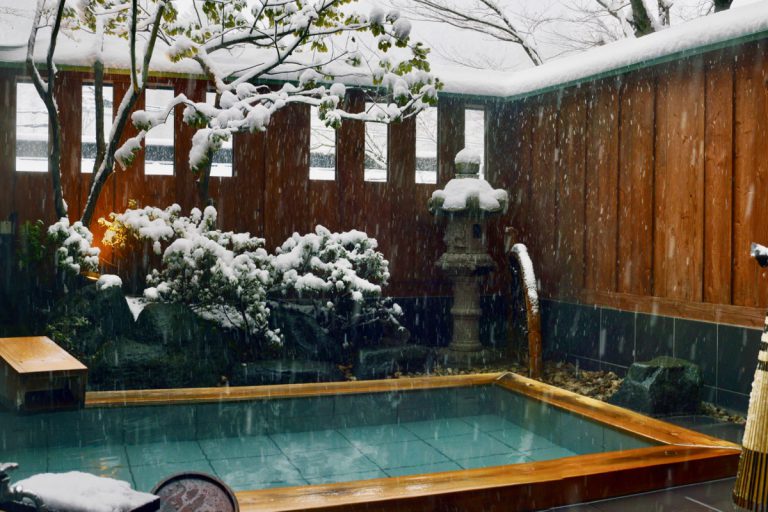
Taking a hot bath is a time-honored Japanese tradition. Whether at home, at the community sento, in super-modern hot spa “day resort,” or, best of all, in at a traditional hot spring ryokan inn, the Japanese love to soak away the hours. And no trip to Japan would be complete without experiencing the pleasures and benefits of the traditional Japanese hot spring spa or onsen. Note, as far as etiquette goes, remember to behave respectfully, and most importantly WASH BEFORE SOAKING!! If in doubt, do like the Japanese around you. Enjoy!!
In Kyoto City: Kitashirakawa Natural Radium Onsen: the water at this mountainside spa has been proven to have special powers; free pickup and drop off. Funaoka Onsen: This onsen, the oldest one in the city, has a number of exquisite ranma (Japanese carved wooden panels) which partition the change rooms; 15:00-1:00; on Kitaoji west of Daitoku-ji Temple. Kurama Onsen Spa: This outdoor spa, set on a forested, mountain slope at the north end of the narrow Kurama valley, is only 30-minutes by train from Kyoto; crowded during the day on weekends; 9:00-21:00, closed Mondays; Tel: 741-2131. Nizaemon No Yu Onsen: This place has everything: outdoor pools; masseurs; skin treatment specialists; restaurants; etc. On highway #9 (or Gojo Street; towards Kameoka), on the west side of town a little southwest of Hankyu Katsura Stn. (the spa is 8 min. by taxi from the station); 10:00-02:00 (from 8:00 on weekends and holidays); Tel: 393-4500.
Near Kyoto: Ayabe Onsen: The old castle town of Ayabe, about two hours northwest of Kyoto City by train (or car), once a major producer of raw silk, is the home of Kurodani washi paper. Ayabe‘s spa (overnight from ¥8,800, including breakfast and dinner) is said to be good for neuralgia, fatigue, burns and bruises, due largely to the water’s very high sulfur content. Tel: (0773) 55-0888. Yu-no-hana Onsen Area (Kameoka City): The 12 ryokan inns of the Yu-no-hana onsen outside of Kameoka have a reputation for healing neuroses, rheumatism, skin diseases, and stomach aches. Entry: for bathing only: Hotel Keizankaku (¥1,500), Ikoi no Ie Yoshinkan (¥640). Tel: (0771) 22-5645 (Yu-no-hana Ryokan Association). Shizuka No Sato (Amino Town): With its panoramic view of the Japan Sea, this spa is popular year round. Tel: (0772) 72-4126. To get there, take the direct Tango Discovery from Kyoto Stn. (at 12:25), or take the JR Saiin line to Amano Hashidate (5 times a day) and transfer to the Kitakinki Tango line. Get out at Amino Stn. Yasaka Ashiginu Onsen (Yasaka Town): This large spa, in the heart of the spectacular Tango Peninsula, has 9 different kinds of baths. Tel: (0772) 65-2000. To get there, take the direct Tango Discovery from Kyoto Stn. (at 12:25) to Mineyama. The onsen is a 10-min ride by taxi from the station.
Best onsen in and around Tokyo: Tokyo Odaiba Oedo Onsen Monogatari (Tokyo); Nikko Yumoto Onsen (Nikko); Yamato no Yu (Narita); Shibu Onsen (Nagano); Shirahone Onsen (Nagano); Nozawa Onsen (Nagano).
- Japan January travel food highlights
- Japan January travel tree and flower highlights
- Japan January travel festival | event highlights
- Winter onsen hot spring pleasures
- Trad Japan winter things: ceramic hot pots, hanten coats, hot water bottles
- Interview with Yoshinobu Hamano, 3rd generation tofu maker
Trad Japan winter things: ceramic hot pots, hanten coats, hot water bottles
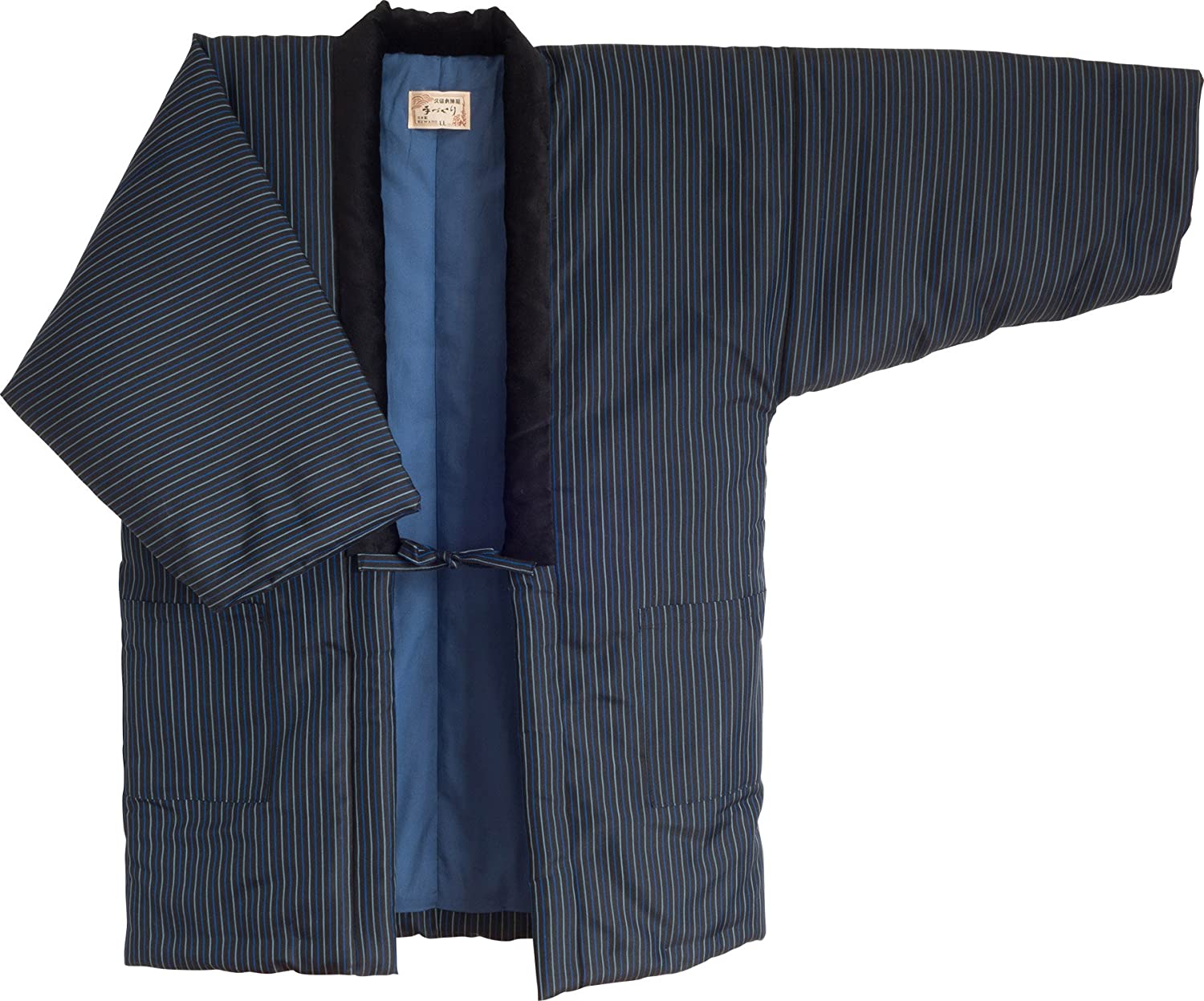
Most traditional Japanese handicrafts are simple, inexpensive and created for daily use. The items described below all relate the reality of winter in Japanese daily life and are also perfect for bringing home where so many foreign travelers also have winter weather.
Ceramic nabe hot pots: Cooking up all kinds of things in communal (like fondue) nabe pots is big in Japan in winter both at restaurants and at homme. These durable, wide, deep ceramic cooking pots (with lids of course!) are a great thing to bring home from Japan. They are often adorned with traditional seasonal motifs. If you do happen to buy a ceramic nabe pot, consider getting a portable gas burner so that you and your family and friends can experience Japanese communal cuisine. Japanese winter hanten coats & vests: Japanese traditional homes don’t have central heating. They use electric or kerosene space heaters and traditional padded, wonderfully patterned, hanten coats and vests. Look great, stand out, and be extra warm this winter with a Japanese hanten coat or vest! Finding these clothing items isn’t easy but all big department stores stock them. Ask and Yee shall find!Traditional hot water bottles: Getting into a cold futon bed or Western bed on a bitter winter night is always a bit a challenge in Japanese traditional homes. A ceramic bottle of hot water (normally placed at the foot of the bed) is a smart way to get around cold shock upon entering the sleeping arrangement (futon or bed). Japanese hot water bottles are called yutampo. They used to be made of metal and some still are but the best ones are made from clay! Again, this item is not super easy to find but traditional hardware shops have them and if you ask around you are sure to locate one in traditional neighborhoods in Kyoto and Tokyo.
- Japan January travel food highlights
- Japan January travel tree and flower highlights
- Japan January travel festival | event highlights
- Winter onsen hot spring pleasures
- Trad Japan winter things: ceramic hot pots, hanten coats, hot water bottles
- Interview with Yoshinobu Hamano, 3rd generation tofu maker
Interview with Yoshinobu Hamano, 3rd generation tofu maker
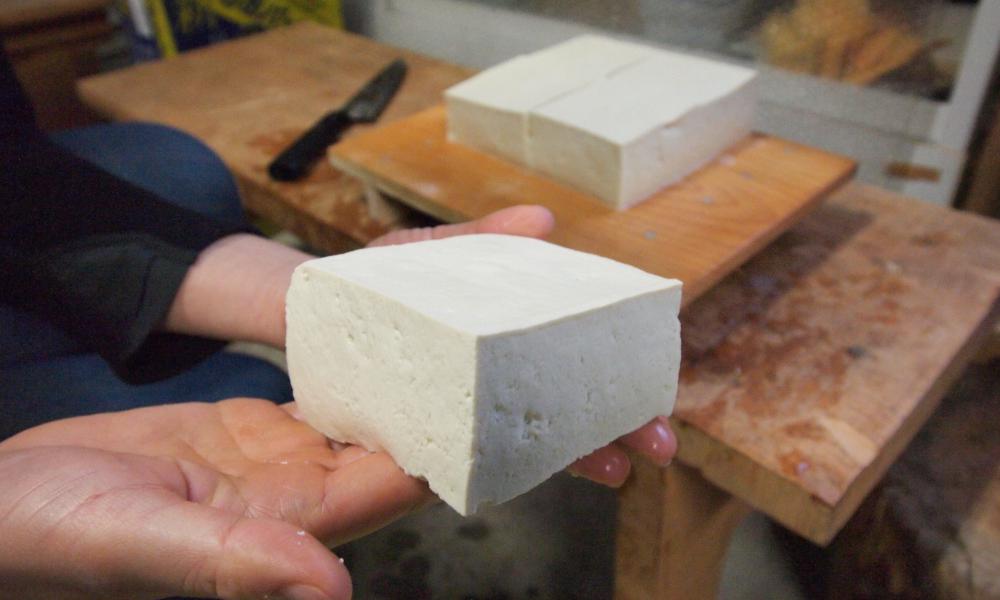
Yoshinobu Hamano is the president of Kyo-no-yuki Hompo, a 3rd generation tofu business, established by his grandfather in 1924. He was born in Kyoto in 1949 and became the company president in 1983. This interview was conducted in March 1998.
Brought up in the digital world, he quickly expanded the company through the use of microprocessors and automated production, while maintaining the highest quality control standards. His tofu company, with about 30 employees, is located between Nishi and Higashi Hongan-ji temples. In 1996, he opened a tofu restaurant and shop, call Tofu-jaya, in the up-scale Pontocho entertainment district just west of the famous Gion geisha district. He is also thinking about opening one abroad . . .
YJPT: Is there a big difference between hand-made and machine-made tofu?
Mr. Hamano: The tofu making process, the steps involved, are the same whether you make it by hand or with an automated process. The biggest difference is in how much you can produce, and the fact that you are able to maintain strict quality control. The quality of hand-made tofu is very much influenced by your physical, emotional and spiritual state of health. Since tofu making is something you do every single day of the year, the result can be very bad indeed if you are sick or don't feel good. So with hand-made tofu there are good days, and bad days. With a computer, you can strictly control the amount of water, temperature, and pressure required. These conditions change with the seasons, and so does the taste of the tofu, but it is never bad. At present, we produce about 10 times more than when it was all done by hand. We used to have five employees; now, in our new three-story factory, we have 30 people, producing about 10,000 pieces of various types of tofu a day. Basic block tofu accounts for about 3,000 pieces, and deep-fried age for about 5,000 per day. Our special brand tofu is made with locally grown Kyoto soybeans, from Kameoka, called Otsuru. This is the only brand of tofu we serve in Tofu-jaya, our restaurant.
YJPT: How has the modern tofu industry changed, given the increasing amount of Western cuisine in the Japanese daily diet?
Mr Hamano: Tofu demand and supply have not changed much since the war. What has changed is the range of tofu cooking styles and uses. During Kyoto's 1200 year history as the capital, there were only two kinds of tofu—yudofu, or hot pot tofu, and hiyayakko, or chilled tofu served with ginger, soy sauce and scallions. Today, tofu is being used in oriental cuisine, and in western recipes. It is used for sauces, as a meat substitute in vegetarian restaurants, and as an increasingly popular dessert ingredient.
YJPT: In terms of health, is there a limit to the amount of tofu you can eat every day?
Mr. Hamano: I eat one entire package of tofu every day, and I think I'm pretty healthy. Basically, you can eat as much tofu as you like. The average Japanese household consumes three to four blocks of tofu a week. The great thing about tofu is the exceptional value. It's not expensive, and everyone knows it's healthy. No matter if you are rich or poor, a man or a woman, young or old, everyone loves tofu. It has few calories, no cholesterol, lots of vitamins, and it isn't hard on your teeth or your stomach. It's amazing, really.
YJPT: Where do you distribute your tofu products?
Mr. Hamano: Kyoto-no-yuki Hompo tofu is distributed to about 60 locations every day. Our clients include: supermarkets, department stores, hotels, ryokans, restaurants, and temples throughout Kyoto. We deliver directly every single day. There is no one between us and our clients. As I mentioned before, the tofu business is an every-single-day kind of business. There are no holidays; we work 365 days a year, even New Year's day.
YJPT: What are the essential factors in making great tofu?
Mr. Hamano: The most important thing is technique. The second most important thing is water quality. Third is the quality of the soy beans used. And the fourth most important thing is the quality of the nigari (natrium chloride), the coagulant that turns soy milk into tofu. The best nigari is obtained from sea water. Tofu quality and, naturally, taste are strongly influenced by temperature and general changes in climatic conditions; you can not use the same technique in the winter time that you use in the summer time. This is especially true in Kyoto, where summer and winter temperatures can differ by as much as 30 degrees. That is why a good tofu maker must master every aspect of the technique so that he can take advantage of every subtle flexibility. This is my philosophy.
YJPT: Why is Kyoto so famous for its tofu?
Mr. Hamano: Kyoto has the highest concentration of temples of any city in Japan, and therefore the most monks. Monks are trained in their monastic life to be vegetarians, and so tofu plays a big part in their diet. Because of this, Kyoto's tofu industry has always been competitive. There is always a demand for more variety, and for the best, natural high-quality product.
YJPT: Please tell us about your restaurant, Tofu-jaya.
Mr. Hamano: I opened Tofu-jaya as part of my deep desire to promote the three major cultures of Kyoto—food, lifestyle, and entertainment— through tofu cuisine. Tofu-jaya is a small restaurant. It only has 21 seats, but in that intimacy you can enjoy the beauty of a traditional Kyoto interior, and a totally new approach to tofu cuisine. Right now, the restaurant and shop is staffed by fourteen people working in three shifts from eight in the morning to eleven at night. I usually put in an appearance once a day. My dream is to open a chain of Tofu-jaya restaurants throughout the world. I'm hoping to open my first international branch in New York, in a few years. I would like to present Kyoto culture to the world and New York still seems to be the place for everything new and modern. In my opinion, New York is still somehow the center of the world for starting up new businesses.
YJPT: Finally, what do you think about modern Kyoto?
Mr. Hamano: Compared to 20 years ago, Kyoto has made a great deal of progress in the modern sense. But almost all of this so-called progress has been made without considering the essence or uniqueness of Kyoto. In my opinion, Kyoto does not need more highways, subways, or under-ground shopping malls. What we really urgently need is more governmental—municipal, prefectural and national—support to preserve our unique traditional culture, architecture, and natural resources. If we focus more on that, Kyoto has immense potential and possibilities. The ignorance or indifference of citizens regarding the politics of Japan must stop. There is no harm in stating one's opinion. That's what makes a democracy healthy. We need to be more concerned and more vocal about where we live. We need to show more pride in and respect for our heritage.
Japan month by month private travel & culture summary index
Japan spring travel: Mar, April, May. Learn more!
Japan summer travel: June, July, August. Learn more!
Japan autumn travel: Sept, Oct, Nov. Learn more!
Japan winter travel: Dec, Jan, Feb. Learn more!
Content by Ian Martin Ropke, owner of Your Japan Private Tours (est. 1990). I have been planning, designing, and making custom Japan private tours on all five Japanese islands since the early 1990s. I work closely with Japan private tour clients and have worked for all kinds of families, companies, and individuals since 1990. Clients find me mostly via organic search, and I advertise my custom Japan private tours & travel services on www.japan-guide.com, which has the best all-Japan English content & maps in Japan! If you are going to Japan and you understand the advantages of private travel, consider my services for your next trip. And thank you for reading my content. I, Ian Martin Ropke (unique on Google Search), am also a serious nonfiction and fiction writer, a startup founder (NexussPlus.com), and a spiritual wood sculptor. Learn more!